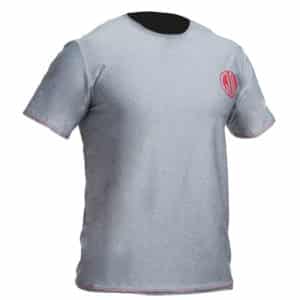Everyone who has ever worn a wetsuit, or surfed somewhere warm without one, will have felt that burning sensation from your chest, neck or armpits being rubbed raw. It usually means time out of the water and no one wants to miss a good swell for a surf rash that is completely preventable by wearing a rash vest.
What causes surf rash?
There are two kinds of surf rash – wetsuit rash and board (or wax) rash.
- Wetsuit rash is caused by a wetsuit, usually a poorly fitting one, rubbing against the skin as your body twists and turns during surfing. Surfers are prone to getting it under the arm pits as they paddle or on the back of the neck from the zip or the back panel neoprene. While the neck and armpits are where it most frequently occurs, you can get it anywhere – behind the knees, naval, the inside of your elbows, anywhere the wetsuit touches your skin.
- Where as board rash is caused by the waxed surface of your surfboard (or bodyboard) chaffing your chest and stomach region as you paddle when not wearing a wetsuit, usually in tropical waters.
How do I prevent surf rash?
One of the simplest ways to prevent wetsuit or board rash is to buy a rash vest (sometimes called a rash guard or rashy).

Buying a Rash Vest
It’s fairly easy to choose a rash vest as there are only a few different kinds to pick from. The colours may vary wildly but the only thing you need to worry about is whether to go for short sleeve or long sleeve and whether to choose a close-fit or loose-fit.
The first rash vests were short sleeved with a long neck and made with Lycra stitched together with overlocked seams. The problem with an overlocked seam is that the rash vest can only be worn the correct way round, otherwise it may cause even more rash!
Virtually all rash vests now have flat-locked seams which lie flat against your skin and are far more comfortable.
Short Sleeve or Long Sleeve Rash Vests?
Whether you choose a short sleeve or a long sleeve rash vest is entirely down to personal preference. If you suffer from elbow rash (trust me, it’s real) then a long sleeve is the way forward. If it’s just armpits and neck that are taking the brunt of the punishment then a short sleeve will be fine.

There has been a fashion for low cut necks on rash vests over the last few years but make sure there is still enough fabric to cover the wetsuit neck. If the rash vest sits lower than the highest point of the wetsuit on your neck, then you will still get a rash.
If you’re lucky enough to be heading to the tropics then a long sleeve rash vest might be more appropriate. The long sleeve will provide excellent sun protection for those just off the plane and you won’t get any unpleasant board (wax) rash. If you like brown arms (and the sharpest, hardest tan lines that it’s possible to get) then head for the short sleeve option.
Close-Fit or Loose-Fit?
The vast majority of rash vests are close-fit. They cling to the skin to provide a reduced friction surface that the wetsuit will easily slide over, minimising wetsuit rash.
Close Fit
If you want a rash vest to be worn underneath a wetsuit but also double as a sun protector as well as preventing board rash then a close-fit rash vest would be ideal.

Loose Fit
Loose-fit rash vests (or surf tee’s) come into their own in the tropics. They prevent board rash and give excellent UV protection (something that a normal t-shirt will not do when it get’s wet) as well as being very comfortable to wear. They also look more like a t-shirt so if you’re not quite sporting that six-pack yet, then no one will know. Loose fit rash vests are not suitable for wearing under a wetsuit. They will bunch up beneath the armpits and be just as painful as wetsuit rash.
Which Rash Vest Should I Buy?
In a nutshell, the short sleeve close-fit rash vest is by far the most popular and will be more than adequate for most surfers. You can use it in the tropics for sun protection when surfing without a wetsuit or when using a wetsuit in colder water.
If you can afford it then buy a close-fit rash vest for wearing with a wetsuit at home and a loose-fit one for the tropics.





